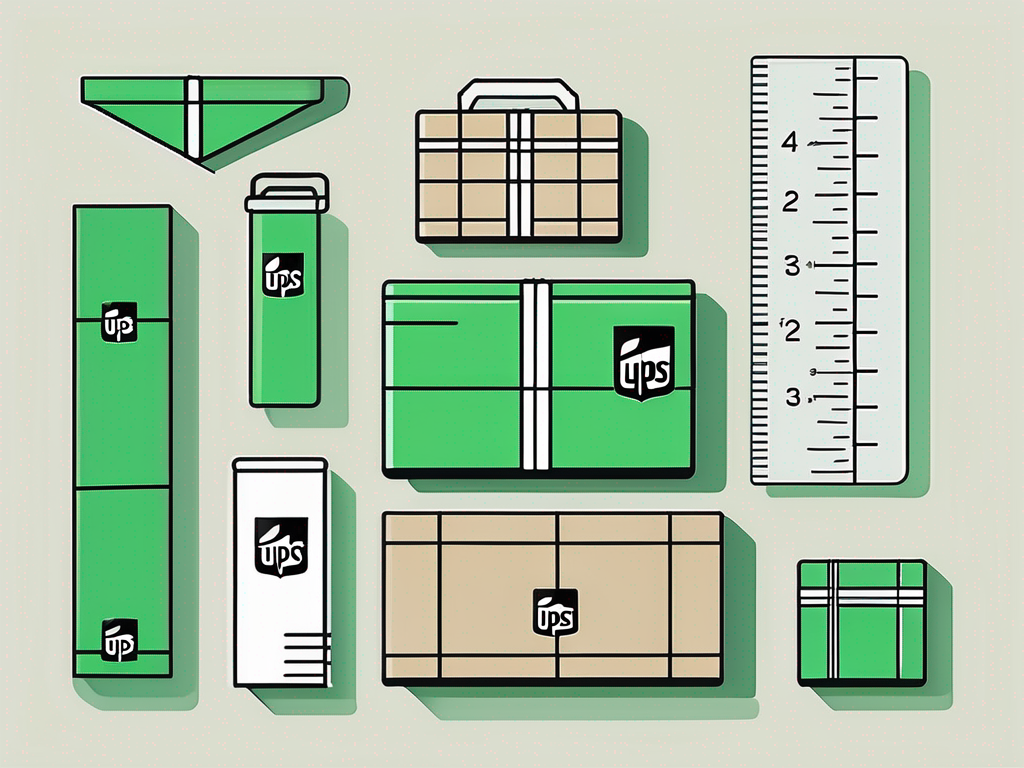Share this
UPS Package Measurements: A Complete Guide
by Shipfusion Team on May. 23, 2025

Knowing the ins and outs of UPS package measurements can make a big difference in cost, efficiency, and delivery success. This guide unpacks why accurate measurements matter and offers practical tips on measuring your packages to optimize your shipping process, avoid unnecessary fees, and ensure a seamless experience.
The Importance of Accurate UPS Package Measurements
Accurate ecommerce package measurements are vital for numerous reasons. UPS, like other carriers, bases its shipping fees on specific dimensions and weight classifications. If your package is inaccurately measured, this can lead to unexpected fees and possible delays in transit.
Ensuring that packages are measured correctly also contributes to safer delivery processes. Proper measurements can reduce the likelihood of issues during transport, from handling problems to disputes regarding shipping costs.
Ensure Safe Delivery
Correct measurements significantly enhance the safety of package delivery. For instance, if a package exceeds the standards that UPS uses for certain transportation methods, it might require special handling or be redirected to a different shipping channel altogether. This could lead to delivery delays or damage to the package.
In addition, packages that fit within the specified dimensions are more likely to stay secure during transit. Properly measured packages can minimize shifting or movement, reducing the chances of damage to the contents inside. Moreover, when packages are accurately measured, they are less likely to become a hazard to other packages or personnel during handling. For example, oversized or awkwardly shaped packages can pose risks on conveyor belts or during manual sorting, leading to potential accidents or injuries.
Reduce Shipping Costs
Shipping costs are primarily determined by the weight and size of a package. When packages are inaccurately measured, shippers might find themselves facing higher costs than anticipated. For example, if you under-measure a package's weight, you may pay initially lower UPS shipping rates but face penalties later on.
On the other hand, adhering to precise measurements allows shippers to choose the most cost-effective shipping options available. With accurate information, you can also avoid potential surcharges based on dimensional weight calculations. Additionally, knowing the exact dimensions and weight of your packages can help businesses streamline their logistics processes.
By analyzing shipping data, companies can identify trends and optimize their packaging strategies, which can lead to improved efficiency and reduced waste. This not only saves money but also contributes to more sustainable shipping practices, as businesses can minimize the use of excess packaging materials and reduce their carbon footprint.
Basics of UPS Package Measurements
Understanding the basics of how UPS measures packages will help ensure that you are well-equipped to handle shipping processes effectively. This section provides insights into what you need to know about measurement standards employed by UPS.
Understanding Dimensional Weight
Dimensional weight is a key concept in package shipping. This calculation considers the volume of the package as well as its actual weight. It is particularly important for lightweight but bulky items, as these could result in higher shipping fees due to their size.
For instance, if a package's dimensions exceed a particular threshold, UPS will charge based on dimensional weight rather than actual weight. Understanding this concept can help you choose packaging that minimizes costs while still protecting the contents.
Additionally, it’s worth noting that UPS uses a specific formula to calculate dimensional weight, which is the length multiplied by the width multiplied by the height of the package, divided by a dimensional divisor. This divisor is subject to change, so staying updated on UPS policies can lead to significant savings.
The Role of Package Size in Shipping Costs
The size of a package plays a critical role in determining shipping costs. UPS applies dimensional weight pricing based on the formula that compares package dimensions to weight. The larger the package, the higher the potential shipping fees, which is essential knowledge for businesses focused on minimizing expenses.
Shippers should always be aware of the limitations set by UPS, enabling them to select the best packaging available. Whether you're shipping small boxes or larger goods, developing an understanding of how size impacts pricing will aid in budgeting and planning. Furthermore, utilizing the right packaging materials can make a difference; for example, using lightweight, sturdy materials can help reduce dimensional weight while ensuring that the items are well-protected during transit. Additionally, it’s beneficial to explore UPS’s various shipping options, such as flat-rate shipping and UPS freight shipping which can provide cost-effective solutions for large package sizes and weights.
Does UPS Always Check the Size of Box?
The short and generally correct answer is yes, UPS does always check box size. Dimensional weight, which is partially determined by package length, width, and height, determines rates for most of UPS' services. There's a balance to be struck in selecting a shipping box size that's both large enough to accommodate ecommerce products without unnecessary dunnage and filler yet not so big it contributes to higher shipping costs. Luckily, that's a job that doesn't need to be done manually.
Shipfusion uses software preloaded with details about every client's SKU, preferred box types, and special project requirements to automatically determine what combination of those three factors is best for individual shipments. Just like UPS always checks the size of a box, we always make sure that box is cost-effectively sized. We can even store and pack with custom shipping boxes if needed.
How to Measure Your Package for UPS Shipping
Measuring packages for shipping may seem straightforward, but adhering to specific guidelines ensures the process is executed effectively. This section covers the essential tools and the measurement steps needed for optimal results.
Tools Needed for Accurate Measurements
The right tools can make a significant difference in achieving accurate package measurements. A standard tape measure is helpful for linear dimensions, while a digital scale can provide precise weight readings.
Additionally, a measuring square or calipers can be beneficial for measuring irregularly shaped packages. Investing in these tools enables more efficient measuring processes and reduces the likelihood of errors. For those who frequently ship items, a shipping scale with a built-in dimension measuring feature can streamline the process even further, allowing you to obtain both weight and size in one step. This not only saves time but also helps ensure that your packages meet UPS requirements without the need for multiple measurements.
Step-by-Step Guide to Measuring Your Package
- First, assess the package type to select the appropriate measurement tools.
- Use the tape measure to determine the length, width, and height of the package, recording the measurements in inches.
- Next, weigh the package using a digital scale and note its weight in pounds.
- Finally, check whether the calculated dimensions fall within UPS guidelines to avoid potential shipping issues.
This systematic approach ensures consistency in measurements across different packages, minimizing chances for error. It's also worth noting that UPS has specific dimensional weight pricing, which means that the size of your package can affect billable weight. Understanding how to measure accurately can save you money in the long run, as packages that exceed certain size thresholds may incur additional fees.
Furthermore, if you're shipping multiple items, consider how they are packed together, as the overall dimensions of the box may differ from the individual items. Proper packing not only protects your items but also optimizes shipping costs.
Common Mistakes Made with UPS Package Measurements
Avoiding mistakes during the measurement process is essential for a hassle-free shipping experience. You don't want to deal with the added costs or headache of failing to accurately determine length, width, height, or weight with UPS. Even a half kilogram discrepancy in can significantly complicate things in a DIM weight based system.
Underestimation of Package Size
Underestimating a package's size can result in shipping complications. If a package is deemed larger than initially quoted after reaching the UPS store or UPS facility, the shipper may incur additional charges or adjustments. Many individuals overlook measuring the protruding elements of a package, such as handles or flaps, leading to significant underestimations in UPS shipment size.
Thoroughly examining the package dimensions before submitting for shipping can help mitigate these risks and ensure accurate billing. Additionally, it’s beneficial to familiarize yourself with the specific guidelines provided by your shipping carrier regarding dimensional weight. Some carriers use a formula that factors in both the cubic size and weight of the package, which can lead to unexpected costs if not properly calculated. By taking the time to measure every aspect of your package, including any irregularities, you can avoid these pitfalls and streamline your shipping process.
Overestimation of Package Weight
Overestimating weight can also have its drawbacks. Shippers who inaccurately assess the weight may end up paying more than necessary. This scenario can be especially common when using bulky yet lightweight materials for packaging.
A reliable scale that delivers accurate readings is essential for achieving the best results. Double-checking your weight measurements can result in substantial savings over time. Furthermore, consider the importance of using the right type of scale; digital scales tend to provide more precise readings compared to mechanical ones.
It’s also advisable to weigh your packages multiple times to ensure consistency in your measurements. In addition, keeping a record of your package weights can help you identify patterns and adjust your shipping strategies accordingly, ultimately leading to more efficient operations and reduced costs.
UPS Package Measurement Policies
Finally, it is essential to be familiar with UPS policies regarding package measurements. Understanding these guidelines not only improves compliance but also enhances the shipping experience.
UPS's Maximum Size and Weight Limits
UPS has established maximum limits for both package size and weight. Packages should not exceed dimensions such as 165 inches in length and girth combined and should not weigh more than 150 pounds for most standard shipping services.
Familiarizing yourself with these limits is vital to avoid surprises during shipping. Packages that exceed these parameters may require special handling or be subject to additional fees. Furthermore, it's important to note that certain services, such as UPS Ground, may have different restrictions based on the destination or specific service level selected, which can further complicate the shipping process.
To ensure your packages meet these criteria, consider investing in a reliable shipping scale and measuring tools. This investment can save time and money in the long run, as accurate measurements can prevent the need for costly adjustments or rerouting. Additionally, UPS offers online resources and tools to help shippers calculate dimensions and weights effectively, making it easier to stay compliant with their policies.
Consequences of Incorrect Package Measurements
Incorrect measurements can lead to several consequences, including delays, extra charges, or return shipments. Inconsistent measurements can create a ripple effect that disrupts the shipping process and affects customer satisfaction.
Considering the potential implications of inaccurate measurements, taking the time to ensure accuracy helps avoid these pitfalls. Establishing a routine for measuring packages can create a reliable shipping process aligned with UPS regulations. Moreover, incorrect measurements not only impact the immediate shipment but can also tarnish your reputation as a reliable shipper. Customers expect timely deliveries, and any disruption can lead to dissatisfaction and loss of trust.
In addition to the financial repercussions, frequent measurement errors can also lead to increased scrutiny from UPS, potentially resulting in stricter monitoring of your shipping practices. This could mean more frequent audits or even limitations on shipping capabilities if the issues persist.
Maintaining diligence in package measurement is not just a best practice; it is essential for sustaining a positive relationship with UPS and ensuring smooth operations in your shipping endeavors. To that end, it can quite literally pay to outsource fulfillment to a third-party logistics (3PL) company capable of guaranteeing accuracy at scale.
Work with a Master of UPS Package Measurements
Mastering UPS package measurements is a simple way to cut costs - and cut edges - off operational costs. When you work with Shipfusion, you're working with a partner who considers this and other carriers' rules by default. That level of peace of mind and economy makes all the difference when scaling in a competitive marketplace.
Learn more about what our tailored solutions can do for you by reaching out to a fulfillment expert today.
Share this
You May Also Like
These Related Articles

Cool Kickstarter Campaigns & Fulfillment Services

Understanding Fulfillment SLA Standards for Ecommerce Success

Warehouse Management for Ecommerce: Strategies That Drive Real Results
- September 2025 (2)
- August 2025 (8)
- July 2025 (16)
- June 2025 (22)
- May 2025 (27)
- April 2025 (27)
- March 2025 (26)
- February 2025 (26)
- January 2025 (34)
- December 2024 (16)
- November 2024 (22)
- October 2024 (22)
- September 2024 (27)
- August 2024 (9)
- July 2024 (8)
- June 2024 (5)
- May 2024 (8)
- April 2024 (7)
- March 2024 (6)
- February 2024 (6)
- January 2024 (5)
- December 2023 (3)
- November 2023 (3)
- October 2023 (5)
- September 2023 (4)
- August 2023 (2)
- July 2023 (1)
- June 2023 (4)
- March 2023 (2)
- October 2022 (1)
- September 2022 (5)
- August 2022 (4)
- July 2022 (7)
- June 2022 (4)
- May 2022 (4)
- April 2022 (6)
- March 2022 (2)
- February 2022 (1)
- January 2022 (3)
- December 2021 (2)
- November 2021 (4)
- October 2021 (2)
- September 2021 (5)
- August 2021 (4)
- July 2021 (4)
- June 2021 (3)
- May 2021 (2)
- April 2021 (3)
- March 2021 (3)
- February 2021 (3)
- January 2021 (2)
- December 2020 (4)
- November 2020 (2)
- October 2020 (4)
- September 2020 (2)
- July 2020 (5)
- June 2020 (4)
- May 2020 (2)
- April 2020 (2)
- March 2020 (4)
- February 2020 (1)
- December 2019 (1)
- May 2018 (1)
- March 2018 (2)
- February 2018 (3)
- January 2018 (3)
- November 2017 (3)
- July 2017 (4)
- March 2017 (3)
- February 2017 (5)
- January 2017 (3)
- December 2016 (4)
- November 2016 (6)
- October 2016 (6)
- October 2015 (1)
- September 2015 (1)
- June 2015 (3)
- May 2015 (3)
- August 2014 (1)
- July 2014 (1)
- March 2014 (1)
- February 2014 (1)